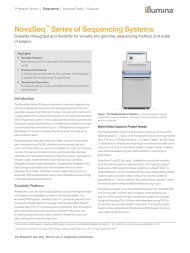Abstracts
ngsfinalprogram
ngsfinalprogram
Create successful ePaper yourself
Turn your PDF publications into a flip-book with our unique Google optimized e-Paper software.
Poster <strong>Abstracts</strong><br />
diversity. The diversity and evolution of toxinotype<br />
V, NAP7 strains are especially important<br />
because these strains are commonly found<br />
in both food animals and humans and many<br />
questions still remain about the potential role<br />
of food animals in CA-CDI. Understanding the<br />
true diversity within C. difficile toxinotypes<br />
and North American Pulsed-field types is also<br />
essential for discussions regarding appropriate<br />
and standardized typing methods.<br />
n 52<br />
A PATHOGENOMICS APPROACH TO<br />
IMPROVE THE ACCURACY OF VETERINARY<br />
CLINICAL DIAGNOSTICS<br />
S. Das 1 , M. Thomas 1 , A. Pillatzki 1 , L. Holler 1 ,<br />
M. Keena 1 , A. Foley 1 , E. Nelson 1 , J. Christopher-Hennings<br />
1 , H. Suzuki 2 , J. Scaria 1 ;<br />
1<br />
South Dakota State University, Brookings, SD,<br />
2<br />
Yamaguchi University, Yamaguchi, JAPAN.<br />
The recent advances in Next Generation Sequencing<br />
(NGS) technology promise cheap<br />
and fast whole genomic data and offer the<br />
possibility to revolutionize veterinary clinical<br />
diagnostics. It is now possible to improve the<br />
accuracy of clinical diagnostics when pathology<br />
data is combined with NGS based clinical<br />
specimen sequencing. This approach offers<br />
faster results and avoids the need for many<br />
different tests to obtain the final interpretation.<br />
We test such an approach in the clinical<br />
evaluation of Salmonellosis cases in Animal<br />
Disease Research and Diagnostic Laboratory<br />
(ADRDL), South Dakota. All bovine<br />
and swine salmonellosis cases submitted to<br />
ADRDL from September 2014 till date was<br />
included in this study. Salmonella isolates were<br />
identified using standard microbiological protocols.<br />
Further characterization of Salmonella<br />
strains were then performed using NGS. Sequencing<br />
libraries for NGS was prepared using<br />
Illumina Nextera XT kit and the sequencing<br />
was performed using Illumina 2 x 250 base<br />
paired end sequencing chemistry. Genome<br />
assembly of the strains was performed using<br />
Spades Assembler v 3.5.0 and annotated<br />
using Prokka v1.11. Comparative genomic<br />
analysis of the isolates was performed using<br />
ITEP tool kit. Antibiotic resistance gene profile<br />
and virulence gene profile of the isolates was<br />
determined using a custom PERL script. These<br />
results were then combined with pathological<br />
data. This combined approach revealed that in<br />
most cases Salmonella infection was accompanied<br />
by presence of other enteric pathogens<br />
such as rotavirus, Clostridium perfringens,<br />
hemolytic Escherichia coli and porcine epidemic<br />
diarrhea virus. Salmonella enterica serotype<br />
Dublin was found to be associated with<br />
septicemia and colitis in the absence of other<br />
pathogens. Antibiotic resistance gene profile<br />
obtained based NGS data provided further<br />
insights into the possible antibiotic susceptibility/resistance<br />
pattern of the strains.<br />
n 53<br />
QUALITY ASSESSMENT OF SINGLE<br />
NUCLEOTIDE POLYMORPHISM IN THE<br />
HIGHLY CLONAL SALMONELLA ENTERITIDIS<br />
D. Ogunremi;<br />
Canadian Food Inspection Agency, Ottawa,<br />
ON, CANADA.<br />
Single nucleotide polymorphism (SNPs) has<br />
emerged as the most informative genetic<br />
variation for the characterization of the highly<br />
clonal Salmonella Enteritidis (SE) to meet<br />
the goals of epidemiological and evolutionary<br />
investigations. Raw reads, contigs, draft<br />
or polished genomes are used to identify SNP<br />
variants typically by aligning the nucleotide<br />
reads of an isolate to a reference genome.<br />
Two relatively well-assembled genomes can<br />
be compared to determine the number of SNP<br />
variants between them. In addition, referencefree<br />
SNP detection from raw reads has also<br />
been proposed and used. There are limitations<br />
to detecting SNPs from the currently available<br />
software and bioinformatics pipelines<br />
and these include the use of a significantly<br />
disparate reference genome to align raw reads,<br />
sequencing errors, mis-assembly and repeats.<br />
To that end, large scale studies investigating<br />
ASM Conference on Rapid Next-Generation Sequencing and Bioinformatic<br />
Pipelines for Enhanced Molecular Epidemiologic Investigation of Pathogens<br />
75



